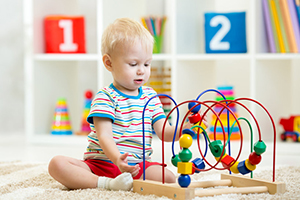Don’t Rush; Reminders to Help Massachusetts Families Buy Safe Holiday Toys in 2021

Don’t rush your holiday toy shopping. Take time to read and follow age-appropriate labels before you buy toys.
Many of us are feeling quite stressed about holiday shopping as we watch the news. Still, when you shop for a child, safety is essential. Slow down and look for a fun, safe and age-appropriate toy that will bring joy, not injury, into your home.
Read Age-Appropriate Warning Labels, Toy Packaging and Online Descriptions
You may think you are buying a safe because the toy was featured on a morning news program or has received top reviews online. But despite your best intentions, you may not actually be purchasing the same toy. To avoid buying a so-called counterfeit toy, look for reputable sellers, such as department stores. Try to purchase from brick-and-mortar stores.
Before purchasing or at home, closely examine the packaging on the toy and make sure it matches the manufacturer’s online description. If you purchased the toy online, the toy packaging should also match the description on Amazon or the online marketplace. Once the toy arrives, open and inspect the box contents.
Everything should be consistent, including the age-recommendation labels.
Check for Toy Recalls
The packaging is a tool to help you shop, as is the CPSC website, which you can check for toy safety recalls. In addition to recalling toys, the CPSC has also recalled many inclined infant sleepers over the past two years. Last summer, the commission approved a new federal safety standard for infant sleep products which will take effect in mid-2022. Here is one of our recent blogs on infant sleep products.
U.S. Toy-Related Injuries and Deaths by Age 2018-2020
No one wants to think about the possibility of a child suffering an injury while playing with their own toys. Yet this is a risk in when so many toys are sold online through Amazon, Ebay and other online marketplaces. Independent sellers can sell on these sites or quickly build their own websites, optimize them in the search engines, then close sites down.
Between 2018 and 2020, 50 children were killed in toy-related accidents across the U.S., according to CPSC data released in May 2021. Many children suffered suffocation and other injuries in accidents involving toys with small parts, balls, stuffed animals or accessories. Two children drowned on water toys. Seven children died in accidents involving non-motorized scooters and two were killed on nonmotorized riding toys.
In 2020, nine children were killed and nearly 150,000 children age 14 and younger were treated for toy-related injuries in hospital ERs. Here is a breakdown of toy-related injuries by age during 2020:
- Children under 5 suffered 40 percent of all toy-related injuries.
- Children age 12 and younger suffered 73 percent of toy-related injuries.
- Children age 14 and younger suffered 75 percent of toy-related injuries.
Common Toy Shopping Mistakes
As we have discussed, you can reduce the risk of injury in your household by reading age recommendations and carefully inspecting toys and packaging. But you can also challenge yourself if you have these thoughts:
Buying Holiday Toys Because Just They Are Available or Priced Right
Earlier this month, the Toy Association shared positive news: 76 percent of parents surveyed said they read age recommendations before buying toys.
However, many can be swayed. About 65 percent of parents said they may buy a counterfeit/knock-off toy if their first choice was unavailable. Meanwhile, 63 percent said they could be influenced by a lower price.
Buying Outside Age-Recommendations for Toys
“This toy is marked age 8 and older, but my 5 ½ year old is up for challenging toys .” Sound familiar? The Toy Association reports 68 percent of parents share this thought and would buy a toy outside age recommendations.
Consider age-recommendation labels an important tool, designed to protect your child from choking, an eye or head injury or a broken bone. Age recommendations are not arbitrary; they are based on a toy’s performance under federal toy safety requirements.
For example, toys with small parts or balls have to undergo the “small parts cylinder” test. The cylinder has a diameter of 1.25 inches, with a slanted bottom opening 1 to 2.25 inches. If a toy or small part passes through the cylinder, it has to carry an age-warning label that states, “Choking Hazard – Small Parts. Not for Children Under 3 Yrs.” Read more about the small parts regulations for toys.
Read more in our Project KidSafe toy safety series.
Free Legal Consultation – Boston Product Liability Attorneys
Founded in 1992, Breakstone, White & Gluck has recovered millions of dollars in compensation for victims of negligence and wrongdoing in Massachusetts. Consistently recognized by Super Lawyers and Best Lawyers, our personal injury lawyers specialize in product liability, holding companies responsible for injuries and wrongful death caused by defective products, toys and vehicles.
Breakstone, White & Gluck is located in 2 Center Plaza in Boston, across the street from the Government Center T stop and Boston City Hall. If you have been injured, Breakstone, White & Gluck offers a free legal consultation. Learn your legal rights by calling and speaking with one of our attorneys today at 800-379-1244 or 617-723-7676 or use our contact form.

